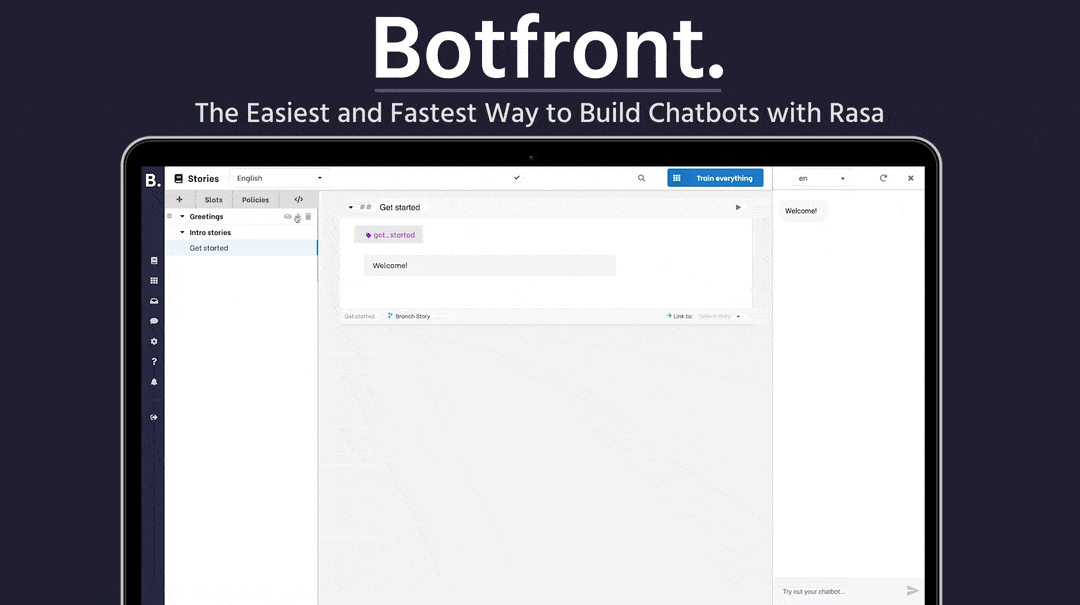Highlights • Features • Quick start • Documentation • Development
Release Notes • Get help • Botfront.io
Conversational projects require easy prototyping, fast implementation and continuous iteration. With Botfront you can build context-aware conversation flows in minutes and accelerate time to market by an exponential factor.
| Our main goal is to lower the technical barrier to entry in conversational AI. Implementing context-aware conversations should be as easy as chatting. | Botfront uses Rasa, a powerful and production ready conversational AI library. Botfront exposes all Rasa functionalities and abstracts its complexity. | Botfront's intuitive CLI orchestrates all Botfront's services on your development machine. Authoring, training, auto reloading actions code, it just works! |
| Botfront provides a unique and natural conversation authoring experience. You can create complex dialog flows in minutes | |
| Botfront comes with a complete NLU toolbox. You can tag vast amounts of data efficiently, train and evaluate models. Several evaluation methods are available depending on the development stage of your model | |
| Botfront is always connected to your agent and conversation data keeps flowing in. You can annotate this data and even use it as an evaluation set and check how this new data improves your model. | |
| Botfront exposes all Rasa features and concepts and and makes them accessible at a higher level for faster development. You can export a Botfront project and use it with Rasa at any time. |
Botfront only requires a recent version of Docker. You can install the CLI with the following:
npm install -g botfrontThen just run botfrontto get started.
The official documentation of Botfront is hosted on botfront.io. It is automatically built and updated on every new release. Once you've installed the cli you can also use botfront docs to open it.
- Botfront is a Meteor app, so the first step is to install Meteor
- Then clone this repo and install the dependencies:
git clone https://github.com/botfront/botfront
cd botfront/botfront
meteor npm install- Install the CLI from the source code:
# if you installed Botfront from npm uninstall it.
npm uninstall -g botfront
# Install the cli from the source code
cd cli && npm linkBotfront needs to be connected to other services, especially Rasa. To do this, you need to create a regular project, and start Botfront with a dedicated configuration:
- Create a Botfront project with
botfront init(somewhere else, not in the repo) - Start your project with
botfront up -e botfront. This will run all services except the Botfront app, since you are going to run it with Meteor locally - Go back to the botfront checkout
cd botfront/botfrontand run Botfront withmeteor npm run start:docker-compose.dev. Botfront will be available at http://localhost:3000 so open your browser and happy editing 😸
Some botfront cli commands that may help if you run into problems:
botfront init # create a new botfront project
botfront logs # show the logs!
botfront killall # stop all docker services
botfront down # stop all botfront services
botfront up # restart botfront
botfront docs # open the docs in your browserNote that these should be run from the same directory as your botfront project
We ❤️ contributions of all size and sorts. If you find a typo, if you want to improve a section of the documentation or if you want to help with a bug or a feature, here are the steps:
- Fork the repo and create a new branch, say
fix-botfront-typo-1 - Fix/improve the codebase
- Commit the changes. Commit message must follow the naming convention, say
fix(conversation builder): display story groups in alphabetical order - Make a pull request. Pull request name must follow the naming convention. It can simply be one of your commit messages, just copy paste it, e.g.
fix(readme): improve the readability and move sections - Submit your pull request and wait for all checks passed (up to an hour)
- Request reviews from one of the developers from our core team.
- Get a 👍 and PR gets merged.
Well done! Once a PR gets merged, here are the things happened next:
- all Docker images tagged with
branch-masterwill be automatically updated in an hour. You may check the status on the Actions tab. - your contribution and commits will be included in our release note.
To help everyone with understanding the commit history of Botfront, we employ commitlint to enforce the commit styles:
type(scope?): subject
where type is one of the following:
- build
- ci
- chore
- docs
- feat
- fix
- perf
- refactor
- revert
- style
- test
scope is optional, represents the module your commit working on.
subject explains the commit.
As an example, a commit that improved the documentation:
docs(conversation builder): update slots manager screenshot.
Copyright (C) 2019 9300-2038 Quebec Inc. All rights reserved.


